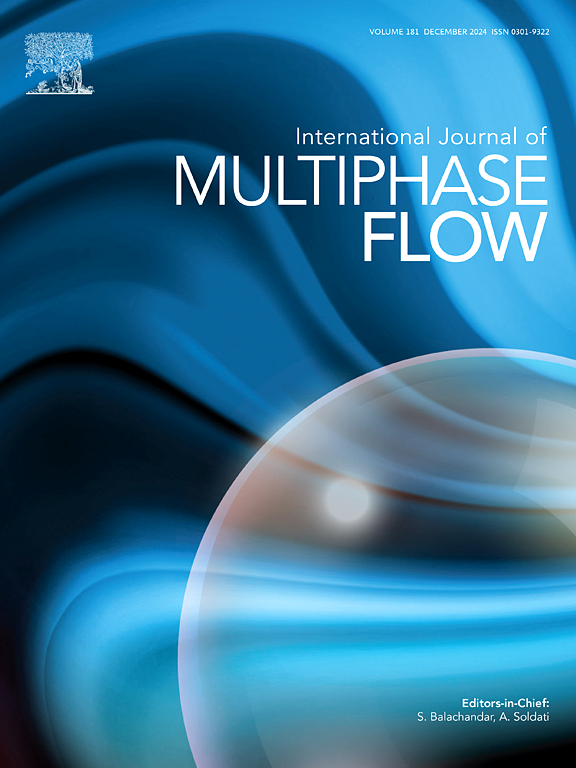Ionic strength-driven cavitation nucleation: From energy deposition-based to tension-based cavitation
IF 3.6
2区 工程技术
Q1 MECHANICS
International Journal of Multiphase Flow
Pub Date : 2025-06-10
DOI:10.1016/j.ijmultiphaseflow.2025.105306
引用次数: 0
Abstract
In this work, we present a unified experimental and simulation investigation of cavitation in aqueous electrolyte solutions, combining nanosecond laser-induced optical breakdown and all-atom molecular dynamics (MD) simulations under tensile stress. Across both cavitation scenarios, we find that cavitation inception and intensity (bubble nucleation count, cavitation-zone length, vapor-volume fraction) are governed by ionic strength alone, with negligible dependence on the ion species. In laser experiments, increasing ionic strength lowers the breakdown threshold and amplifies bubble generation by supplying extra seed electrons for inverse Bremsstrahlung-driven avalanche ionization. We elucidate the mechanism of action of the ionic strength through the MD simulations, which essentially quantifies the net charge density in the bulk, and thus its combined influence on the generation of seed electrons and the perturbation of the hydration network. These findings identify ionic strength serving as a unifying parameter controlling cavitation in electrolyte solutions: whether driven by rapid energy deposition or by tensile stress imposed.
离子强度驱动的空化成核:从基于能量沉积到基于张力的空化
在这项工作中,我们提出了一个统一的实验和模拟研究在水电解质溶液中空化,结合纳秒激光诱导的光学击穿和全原子分子动力学(MD)模拟在拉伸应力下。在两种空化情况下,我们发现空化的开始和强度(气泡成核计数,空化区长度,蒸汽体积分数)仅由离子强度决定,而对离子种类的依赖可以忽略不计。在激光实验中,离子强度的增加降低了击穿阈值,并通过为逆韧致雪崩电离提供额外的种子电子来放大气泡的产生。我们通过MD模拟阐明了离子强度的作用机制,该模拟基本上量化了体中的净电荷密度,从而对种子电子的产生和水化网络的扰动产生了综合影响。这些发现确定了离子强度作为控制电解质溶液中空化的统一参数:无论是由快速能量沉积还是由施加的拉伸应力驱动。
本文章由计算机程序翻译,如有差异,请以英文原文为准。
求助全文
约1分钟内获得全文
求助全文
来源期刊
CiteScore
7.30
自引率
10.50%
发文量
244
审稿时长
4 months
期刊介绍:
The International Journal of Multiphase Flow publishes analytical, numerical and experimental articles of lasting interest. The scope of the journal includes all aspects of mass, momentum and energy exchange phenomena among different phases such as occur in disperse flows, gas–liquid and liquid–liquid flows, flows in porous media, boiling, granular flows and others.
The journal publishes full papers, brief communications and conference announcements.

 求助内容:
求助内容: 应助结果提醒方式:
应助结果提醒方式:


